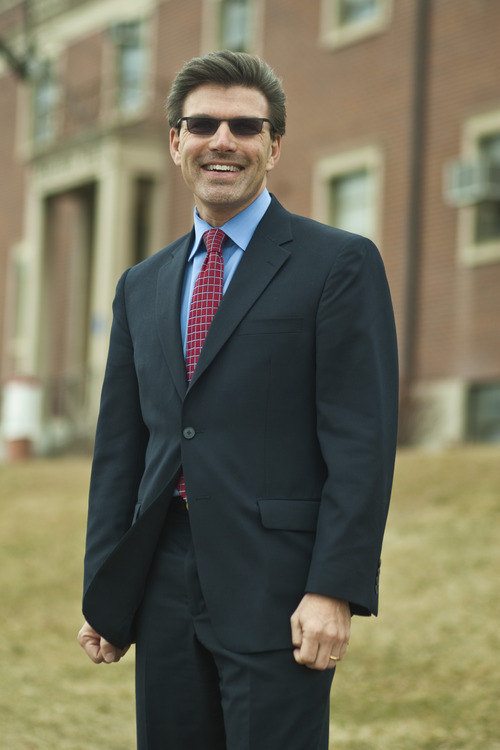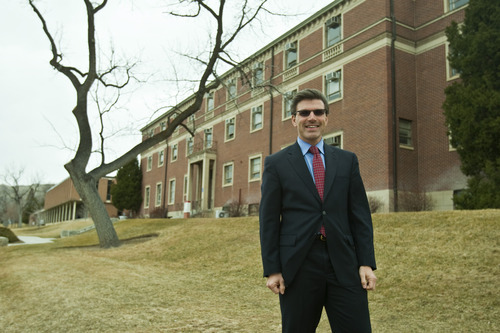This is an archived article that was published on sltrib.com in 2012, and information in the article may be outdated. It is provided only for personal research purposes and may not be reprinted.
The University of Utah's southwest corner is a major campus entryway, where thousands enter and exit the school every day by foot, rail, car and bicycle. But little effort has gone into designing an inviting public space here.
Until now.
A $60.5 million proposal to build a new home for the S.J. Quinney College of Law includes a plaza, outdoor cafe and an architecturally striking building that would create a real gateway across the street from Rice-Eccles Stadium. And a basketball court may appear on asphalt currently reserved for cars.
A campus gateway would be a side benefit to the project's true objective, which is to create a building capable of supporting the U.'s legal-education programs, according to law dean Hiram Chodosh. And it would be funded entirely with non-state money, most of which has been pledged.
"We are building a teaching hospital for law," Chodosh said. "We are building clinical and practical training into our program, as well as the ethos of service in each and every student."
U. law students already provide more than 45,000 hours of legal services per year, more than any other law school on a per-student basis, according to Chodosh. But accreditation teams in 2001 and 2009 pointed out deficiencies in the school's current facilities that could jeopardize its accreditation, although they praised its educational initiatives.
"Our accreditation only survived because of the vision of the future," Chodosh said.
For the first half of its life, the law school was run out of the Park Building before moving into its current home, built in 1963 to forestall a loss of accreditation then. In the early 1980s, the college completed the law library immediately to the east, and some of its offices have spilled into neighboring Carlson Hall.
The school provides only seven square feet of non-classroom space per student. Peer institutions provide four to five times that amount. The proposed building will add about 60,000 square feet overall.
The law school has made do with obsolete facilities while establishing a more student-centered curriculum, incorporating technology into the classrooms and library, wrangling research grants and assembling programs where students work together tackling real-world problems, sometimes with real-world clients.
"It is clear to all external observers, for this kind of high-value program we need to have the right facility," Chodosh said, "It's not just about more space, it's about smart space. We've built in the notion of multi-use."
The Utah Legislature signed off on the proposal, and the U.'s proposed school of dental medicine, during this year's session. Lawmakers endorsed a plan to use an anonymous $37 million pledge to construct a home for the dental school, a 67,000-square-foot building to be located at the health sciences campus or in Research Park.
Groundbreakings for both projects would be in 2013, the law school's centennial year. The law school, which currently serves 400 students, reduced its incoming class this year to 115 in response to the shrinking legal job market.
"The new building would allow long-term expansion to 450 students but no more than that. I believe in that architectural constraint because we are not going to an assembly-line form of legal education," Chodosh said.
One lawmaker chided U. officials for the $388-per-square-foot cost, claiming such a project would never be undertaken by the private sector. But Chodosh said the investment will be recouped in lower operating costs and a long-lived building that will still be functional in 50 years.
The law school will be built to the east of its three existing structures, which will be razed when it's ready for students in 2014. Among them is Carlson Hall, the 1937 masonry building fronting University Avenue that was once one of Utah's first campus buildings for female students and is listed on the National Register of Historical Places.
Its sacrifice is necessary to develop the entry plaza. The former building sites would be landscaped, extending the campus' green buffer strip south from Presidents Circle all the way to the stadium parking lot. This component of the law project is essential for creating a much-needed interface between campus and community.
"That corner is key to that transition and public access to the academic core of campus," said John McNary, the U.'s director of campus design and construction. "We are trying to develop a more lively engaging campus. It is not just walking between buildings. We want the outdoor spaces between buildings to be part of the campus experience."
S.J. Quinney College of Law
The University of Utah is moving forward with a plan to build a new $60.5 million home for its law school. Officials have done extensive programming for the project, but they still need to raise the money and design the 155,000-square-foot building. An architect will be chosen in the coming months. The school's three existing structures lining University Avenue will be razed, and a campus gateway will be developed at the corner with South Campus Drive. Groundbreaking is slated for May 2013, and the building should be ready for students by 2014-15 school year.









